London 2012: Capital embraces Olympic spirit
- Published
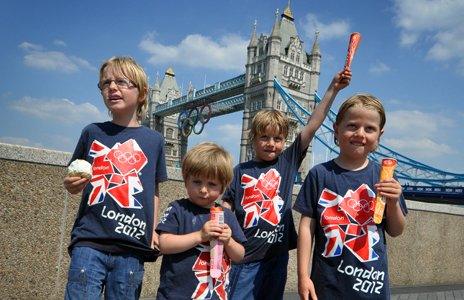
The Peacock family, from Kent, have no tickets for the Games but wanted to see London in its full Olympic glory
With just hours to go before 2012 London Games begin, the capital has come alive with the spirit of the Olympics.
On the south bank of the Thames, crowds of tourists mingle with Londonders keen to take a photograph of Tower Bridge adorned for the summer with the Olympic rings.
Many are dressed in union jack T-shirts or official Games-branded clothing.
Among them are the Peacock family, from Tunbridge Wells in Kent. Brothers Miles, Bradley, Fergus and Stefan spent the day outside the Olympic Park in Stratford, east London, taking in the impressive sight of the main stadium before travelling to Tower Bridge for a well-earnt ice cream.
If the boys could compete, they say, it would be at shooting, cycling or karate.
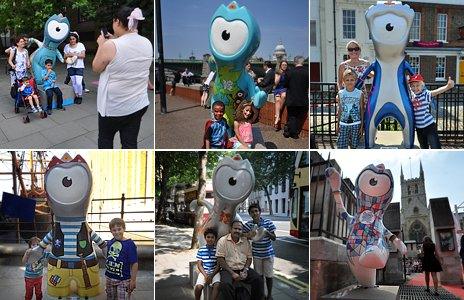
Some of the biggest draws throughout the city are the 83 6ft (2m) statues of the Olympic mascot, Wenlock, and Paralympic mascot, Mandeville, which appeared among London's cityscapes and landmarks in mid-July.
The sculptures are part of several discovery trails to help tourists negotiate the city's landmarks and hidden gems.
The figures often reflect the monument at which they are situated, or capture an element of London life. A pirate Wenlock welcomes people aboard the Golden Hinde, while a stained-glass Wenlock stands at Southwark cathedral.
Many families are seeing how many mascots they can be photographed with in one afternoon.
Fiona Hollis brought her children, Alex Berard and Luca Johnson, to the riverside for the day to sample the atmosphere "before it gets too insane".
Ms Hollis says: "All the train stations look very impressive, and, as a Briton, I am really proud of it all."
Charlie Burns, from Kent, works near London Bridge and came to the river to enjoy her lunch in the sunshine, next to one of the sculptures.
As a commuter, she had concerns about the effect on train travel.
"I am sure the Olympics will be good, but I am dreading the travelling, as the trains are already busy," she says.
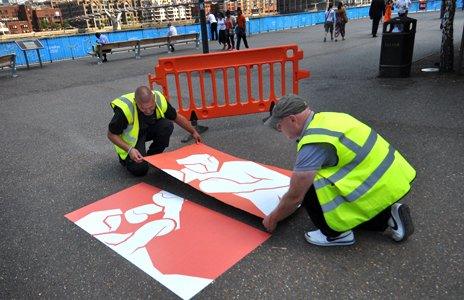
Southwark Council has laid 110 pictograms on the pavement along the south bank to Tower Bridge, each depicting an Olympic sport.
Meanwhile thousands of volunteers have become ambassadors of the London Games, external and are peppered across the city at numerous information stations.
After three days of training, which included a security induction, a guide to cultural events in the city and an orientation day, the volunteers were unleashed on the streets to help visitors.
One of the ambassadors, Mike Marriot, says they have been handing out maps and booklets and have "been asked all sorts of things".
"It's mainly about where to see events for free. But people also want to know everything from how much water they can take into the stadium to where they can collect their tickets."
Fellow volunteer David Hastings says he has watched some of the dress rehearsal for the Olympic ceremony, but "could not give too much away".
"The ceremony reflects Britain's green and pleasant land, and some of it was very interesting.
"There are big screens around the stadium, but we were not shown what will be on them, just told a film would be shown.
"The landscape is moved around and changed by the performers, a bit like the characters in the film Transformers."
Mr Hastings adds the ceremony's director, film-maker Danny Boyle, seemed pleased at the way the trial event had gone.
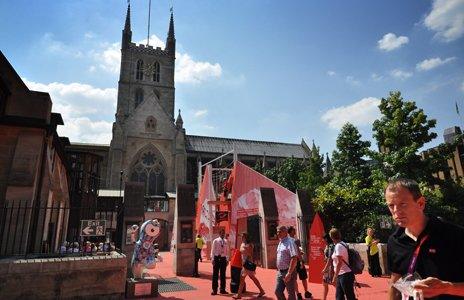
Bases for many of the competing countries have been set up throughout the city.
Known as houses, the areas will provide hospitality for athletes and VIPs and some will open to the public to host medal ceremonies, exhibitions, concerts and parties.
One of the biggest has been constructed by Switzerland at Glazier Hall near Southwark Cathedral.
Among the public attractions are a climbing wall and outdoor plaza where Swiss-themed food and drink can be bought and consumed.
The Brienz School of Woodcarving is holding demonstrations of its craft, and visitors can have their facial silhouette intricately cut out in paper by experts from the Gstaad Zweisimmen craft centre.
Elsewhere, Brazil has taken over the arts and cultural centre of Somerset House on the Strand, showing more than 40 documentaries and short films by film-makers from Rio de Janerio, over the coming weeks.
The Belgian house is located among the cloisters of the 12th-Century Inner Temple in the City of London. Supporters will be able to meet athletes from the Belgian team.
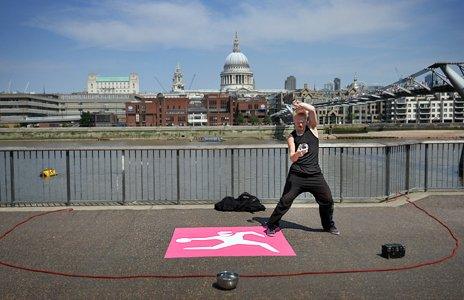
Street performers along the river are hoping the increase in tourism will bring a new audience for their tried and tested acts.
Charlie Hessian has been performing dance and contact juggling in the city for more than three and a half years.
He applied to work at the Games, but accidentally stabbed himself in the eye while juggling shortly before his audition and could not take part.
He says: "London in general is pretty busy at the moment. The Games is good for the city, and I hope more tourists means an increase in revenue for acts like mine."

Tens of thousands of journalists, presenters, camera operators and producers from overseas are setting up temporary stations and sampling the atmosphere on the streets ahead of the Games.
The sport section of Arabic news network al-Jazeera were filming against the spectacular backdrop of Tower Bridge, and American film crews were finding US tourists among the crowds enjoying the summer heat.
Brazilian network Bandsports have set up a broadcast and production area inside a retired red London bus in front of the London Eye near Waterloo station.
Despite concerns about how a predicted 5.3 million visitors will affect London's infrastructure, the view on the city's streets seems to be Britons are excited and proud to host this prestigious sporting occasion.
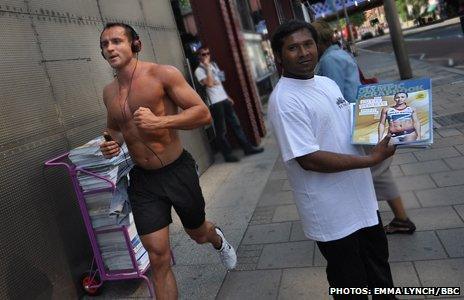
- Published26 July 2012
- Published26 July 2012